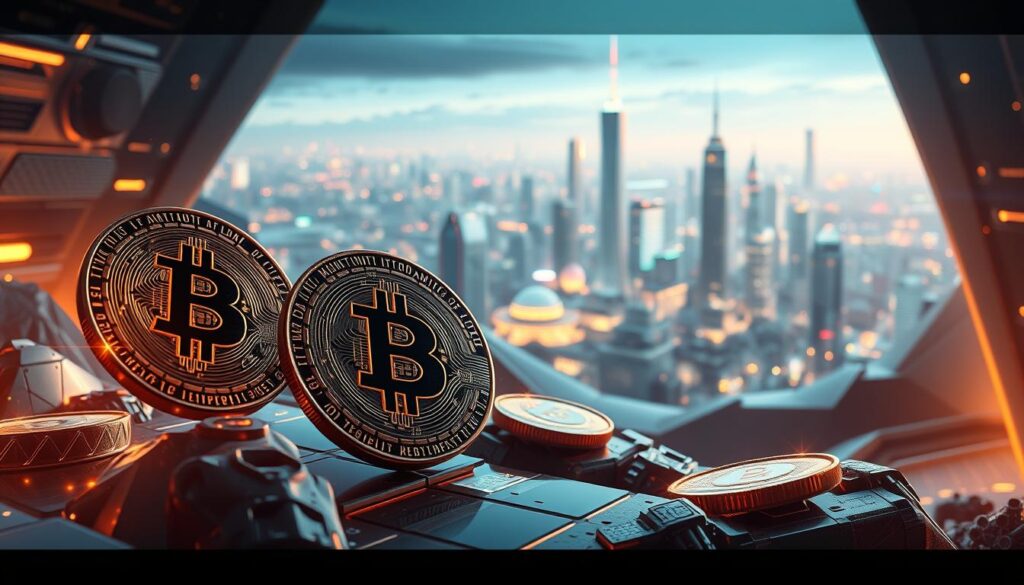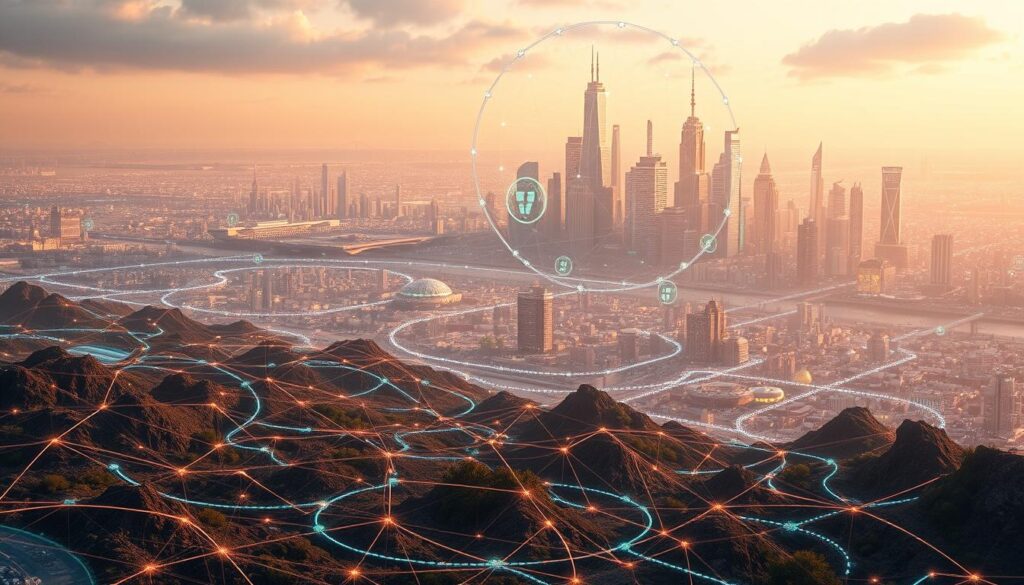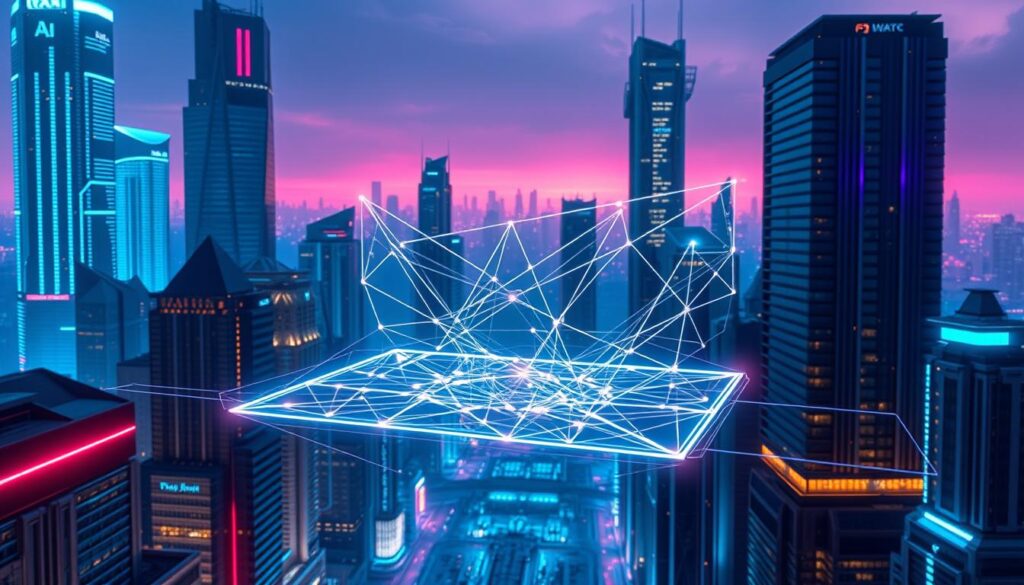Two groundbreaking technologies are reshaping the digital economy. Blockchain networks and advanced algorithms now work together to create self-improving systems. This fusion unlocks opportunities for investors seeking next-generation assets.
Specialized tokens powering these ecosystems have surged in value, with projections suggesting a $27 billion valuation by 2025. These assets enable unique functions like tamper-proof data analysis and self-operating digital protocols. Their growth outpaces traditional sectors, signaling shifting priorities in tech-driven markets.
The combination of distributed ledgers and machine learning creates transparent frameworks. Developers leverage these tools to build adaptive platforms that evolve without centralized control. Such innovations address critical challenges in data security and operational efficiency.
Key Takeaways
- Blockchain-based tokens focused on algorithmic solutions exceed $24 billion in total value
- Distributed networks enable collaborative model development while maintaining privacy
- Secure transaction systems enhance trust in automated decision-making processes
- Self-governing protocols demonstrate practical applications across multiple industries
- Emerging platforms create novel revenue streams through predictive analytics tools
Introduction: The Convergence of AI and Crypto
Advanced computation systems now integrate with cryptographic networks to enable self-managing digital environments. This partnership combines real-time pattern recognition with immutable transaction records, forming a foundation for next-gen solutions.
Core Components of Modern Digital Systems
Distributed ledgers provide tamper-proof data storage, while adaptive algorithms process information autonomously. Together, they create frameworks where smart contracts execute decisions based on live analytics. Developers leverage these tools to build self-updating platforms that maintain transparency.
| Feature | 2024 Implementation | 2026 Projection |
|---|---|---|
| Secure Data Exchanges | Basic encrypted sharing | Dynamic pricing models |
| Computational Resources | Limited peer networks | Global node clusters |
| Automated Protocols | Single-task agents | Multi-chain coordination |
Three-Year Development Trajectory
Specialized digital assets will power 73% of automated systems by 2026, up from 41% in 2024. These tokens facilitate access to decentralized computing grids and privacy-focused analytics tools. Market analysts anticipate a 290% surge in protocol-driven transactions during this period.
Decentralized AI: Transforming Investment and Digital Finance
Innovative systems now merge distributed networks with autonomous computing to reshape financial infrastructures. These frameworks enable secure collaboration across global participants while maintaining strict privacy controls. Real-world implementations range from automated validation protocols to predictive market tools.
How AI Enhances Blockchain Integrity
Advanced pattern recognition strengthens ledger systems through real-time anomaly detection. Distributed model training improves fraud identification accuracy by 83% compared to centralized alternatives. These systems analyze transaction patterns across multiple chains simultaneously.
| Feature | Traditional Systems | Enhanced Systems |
|---|---|---|
| Fraud Detection | Manual reviews | Real-time alerts |
| Validation Speed | 2-3 hours | 12 seconds |
| Error Rate | 4.7% | 0.2% |
Unlocking New Data Processing Capabilities
Shared computing networks enable complex analytics without exposing raw information. GPU clusters process generative workflows 9x faster than single-server setups. Participants earn rewards through:
- Distributed rendering power sharing
- On-chain data indexing services
- Automated contract optimization
Privacy-preserving techniques like zero-knowledge proofs let users monetize information securely. This approach reduces data breach risks by 67% while creating sustainable revenue models.
Top AI Crypto Coins Shaping the Future

The digital asset landscape now showcases pioneering crypto coins driving next-gen computational solutions. These projects leverage distributed networks to automate complex operations, with tokens granting access to specialized services ranging from data processing to resource allocation.
Market Leaders and Innovative Projects
Fetch.ai leads with autonomous agents that optimize supply chains, while Render Token powers a decentralized GPU network for 3D rendering. Bittensor’s marketplace for machine learning models and Ocean Protocol’s secure data exchanges highlight the sector’s diversity.
| Project | Key Innovation | Market Cap |
|---|---|---|
| Virtuals Protocol | Agent tokenization | $1.8B |
| Internet Computer | Web-speed smart contracts | $2.4B |
| The Graph | On-chain data indexing | $1.5B |
Market capitalization for these coins grew 140% in 2023, outpacing traditional tech stocks. Trading volumes surged 68% last quarter as institutions allocated funds to tokens with clear utility. Akash Network’s cloud computing platform and SingularityNET’s AI marketplace further demonstrate how these projects solve real-world challenges.
Distinct tokenomics models fuel ecosystem growth. Staking rewards, governance rights, and fee-sharing mechanisms create sustainable demand. Render Token’s proof-of-render system and Fetch.ai’s agent-collaboration protocols exemplify technical differentiators attracting developer activity.
Product Roundup: A Deep Dive Into AI-Driven Crypto Platforms

Modern computational platforms are redefining value creation through integrated solutions. These systems combine self-learning capabilities with distributed ledger frameworks to deliver measurable results across industries.
Real-World Use Cases and Token Performance
Leading platforms demonstrate practical applications in data analytics and financial services. One project streamlines supply chain tracking using tamper-proof audit trails, while another optimizes energy grids through predictive modeling.
| Platform | Primary Use Case | Token Growth (2024) |
|---|---|---|
| Chainalysis Pro | Fraud pattern detection | +214% |
| NeuroSwap | Predictive liquidity pools | +187% |
| DataMesh | Secure medical research | +156% |
Insights into Autonomous Agent Ecosystems
Self-operating digital workers now handle complex tasks across gaming and social media platforms. These systems earn rewards through micro-transactions and service fees, creating sustainable economic models.
| Agent Type | Core Function | Revenue Model |
|---|---|---|
| Trade Executors | Portfolio optimization | Performance fees |
| Content Moderators | Real-time filtering | Subscription shares |
| Supply Coordinators | Inventory management | Transaction rebates |
Token incentives drive participation in these ecosystems, with staking yields averaging 9-14% across top platforms. Market data shows a 22% quarterly increase in active agent networks since Q1 2024.
Virtuals Protocol: Revolutionizing AI Agent Tokenization

A new frontier in digital asset creation emerges through tokenized digital workers. Virtuals Protocol reimagines value distribution by letting users mint unique tokens representing autonomous agents. Built on Base and Solana blockchains, this platform turns complex algorithms into tradable assets with measurable utility.
Market Momentum and Ecosystem Growth
The VIRTUAL ecosystem reached $1.8 billion in market value by December 2024. Over 21,000 agent tokens launched last November, averaging 1,000+ daily creations. Top performers like AIXBT and VADER demonstrate scalability, each surpassing $300 million in valuation.
Three factors drive adoption:
- Instant listing on major exchanges (Bitget, BingX)
- Tangem wallet integration for secure storage
- Liquidity pool incentives offering 12-18% APY
Tools Fueling Collaborative Development
Virtuals’ GAME SDK empowers creators to build specialized agents through modular coding frameworks. The platform supports 47% of all agent-to-agent transactions across crypto markets. Community initiatives like Virtuals Ventures fund promising projects while liquidity taxes reward early contributors.
November 2024 metrics reveal:
- 3,400+ SDK downloads weekly
- 78% month-over-month growth in active developers
- 19 partnerships with analytics platforms
Bittensor and Fetch.ai: Decentralized AI Training and Execution
Two networks are redefining how machines learn through community-driven collaboration. Bittensor and Fetch.ai demonstrate how distributed systems can outperform traditional frameworks while rewarding participants.
Consensus Mechanisms and Proof-of-Intelligence
Bittensor’s proof-of-intelligence consensus evaluates model outputs across 118 specialized subnetworks. Contributors earn TAO tokens based on solution quality, creating competition among developers. This approach ensures only top-performing algorithms shape the network.
Fetch.ai uses autonomous agents to optimize real-world operations like shipping routes and energy distribution. Its machine learning models adapt through decentralized feedback loops. Both platforms distribute rewards per token staked, aligning incentives across their ecosystems.
Ecosystem Growth and Performance Dynamics
Bittensor’s TAO trades near $322 per token, supported by a $2.9 billion market valuation. The network processes 1.4 million weekly inferences across subnets for text generation and image recognition. Fetch.ai’s proposed alliance could push its valuation toward $6 billion through shared infrastructure.
| Metric | Bittensor | Fetch.ai |
|---|---|---|
| Network Participants | 89,000+ | 142,000+ |
| Daily Transactions | 410,000 | 680,000 |
| Annual Growth | 214% | 187% |
Both ecosystems show strong adoption patterns. Bittensor added 34 new subnetworks last quarter, while Fetch.ai expanded into healthcare data analysis. Their growth highlights the demand for transparent machine learning frameworks.
NEAR Protocol and Ocean Protocol: Scalable AI and Data Marketplaces
Next-generation platforms are transforming how data fuels innovation across global networks. NEAR Protocol and Ocean Protocol lead this shift, offering specialized frameworks for secure collaboration and resource exchange. Their solutions address critical needs in scalable infrastructure and transparent data economics.
Smart Contract Integration for AI Use Cases
NEAR Protocol’s Near Tasks system connects developers with verified datasets through sub-cent transactions. This toolset supports:
- Automated data labeling at 14,000 entries per second
- Human-validated training models
- Cross-chain compatibility with 18+ networks
Ocean Protocol enables private data sharing through compute-to-data solutions. Organizations monetize information without exposing raw files, creating ethical alternatives for model training. Both platforms use native tokens to power transactions, with NEAR trading at $2.68 and Ocean maintaining top-five status among data-focused assets.
| Feature | NEAR Protocol | Ocean Protocol |
|---|---|---|
| Transaction Fees | $0.008 avg | $1.20 avg |
| Active Datasets | 89,000+ | 210,000+ |
| Network Throughput | 4,500 TPS | 900 TPS |
Community Initiatives and Ecosystem Development
NEAR’s ecosystem thrives through developer grants and quarterly hackathons. Recent initiatives funded 47 projects focused on medical research and supply chain optimization. One participant noted:
“The platform’s low fees let us test ideas that traditional clouds would price out.”
Ocean Protocol’s data staking mechanism rewards contributors who validate information pools. Community-driven features include:
- Decentralized governance voting
- Dataset quality scoring
- Cross-platform API integrations
These ecosystems demonstrate how shared infrastructure and community input can drive practical use cases at scale. Over 300 enterprises now leverage their tools for compliant data sharing and analysis.
Enhancing AI Capabilities with GPU Rendering and Data Sharing
Modern computing demands require innovative solutions to handle complex tasks efficiently. Distributed networks now tackle these challenges through collaborative resource sharing, creating new paradigms for processing power allocation.
Powering Next-Gen Processing Networks
Render Token exemplifies this shift with its global GPU network. Artists and developers access rendering power through a peer-to-peer marketplace, reducing costs by 68% compared to centralized providers. The platform processes over 4 million frames monthly, supporting projects from indie films to architectural visualizations.
Secure data exchange protocols ensure contributors maintain control over their resources. Users earn tokens for sharing idle GPUs while maintaining full ownership of their hardware. This model has driven 300% growth in active nodes since 2023.
Recent partnerships with Blender and Unreal Engine demonstrate practical applications. These integrations allow creators to render scenes directly through decentralized networks. Render’s proof-of-work system verifies task completion before releasing payments, ensuring fair compensation.
The platform’s success highlights the value of shared infrastructure for data-intensive workflows. As demand grows, such networks could redefine how industries handle large-scale processing tasks while maintaining user autonomy.
FAQ
How do machine learning and blockchain technologies complement each other in decentralized ecosystems?
Machine learning enhances blockchain integrity by automating fraud detection, optimizing consensus mechanisms, and enabling predictive analytics. Meanwhile, blockchain provides transparent, tamper-proof data storage, creating a symbiotic framework for secure, scalable decentralized applications.
What distinguishes Render Token’s decentralized GPU network from traditional cloud services?
Render Token decentralizes GPU rendering power through a peer-to-peer marketplace, eliminating centralized intermediaries. This model reduces costs for 3D rendering and machine learning tasks while enabling contributors to monetize idle hardware, fostering a community-driven resource-sharing economy.
How does Ocean Protocol’s data marketplace address privacy concerns in analytics?
Ocean Protocol uses compute-to-data frameworks, allowing users to run analytics on private datasets without exposing raw information. Smart contracts govern access permissions and revenue sharing, creating ethical data monetization pathways while maintaining compliance with privacy regulations.
What competitive advantages does Bittensor’s proof-of-intelligence mechanism offer?
Bittensor incentivizes quality machine learning outputs through its proof-of-intelligence protocol. Participants earn tokens by contributing high-performing models to decentralized AI training processes, creating a self-improving ecosystem where rewards align with computational value creation.
Why are autonomous agent ecosystems like Fetch.ai gaining traction in decentralized finance?
Fetch.ai’s autonomous agents automate complex tasks such as portfolio optimization, cross-chain arbitrage, and predictive trading. These AI-driven tools execute real-time strategies with reduced human intervention, unlocking efficiency gains and new revenue streams in decentralized financial markets.
How does NEAR Protocol’s sharding architecture support AI-powered applications?
NEAR’s Nightshade sharding enables horizontal scaling for compute-intensive AI operations. This infrastructure allows developers to deploy resource-heavy machine learning models on-chain while maintaining low transaction fees and sub-second finality, crucial for real-time analytics applications.
What risks should investors consider when evaluating AI-focused tokens?
Key risks include technical feasibility gaps, regulatory uncertainty around decentralized machine learning models, and market volatility from speculative trading. Projects with clear use cases, active developer communities, and verifiable on-chain metrics typically demonstrate stronger long-term viability.


